As I See It
by Mary Schamehorn
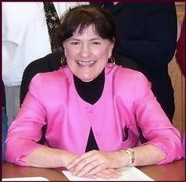
Dec 30, 2020
The first picture I am sharing gives a great look at what the west end of First Street looked like before the Fire.
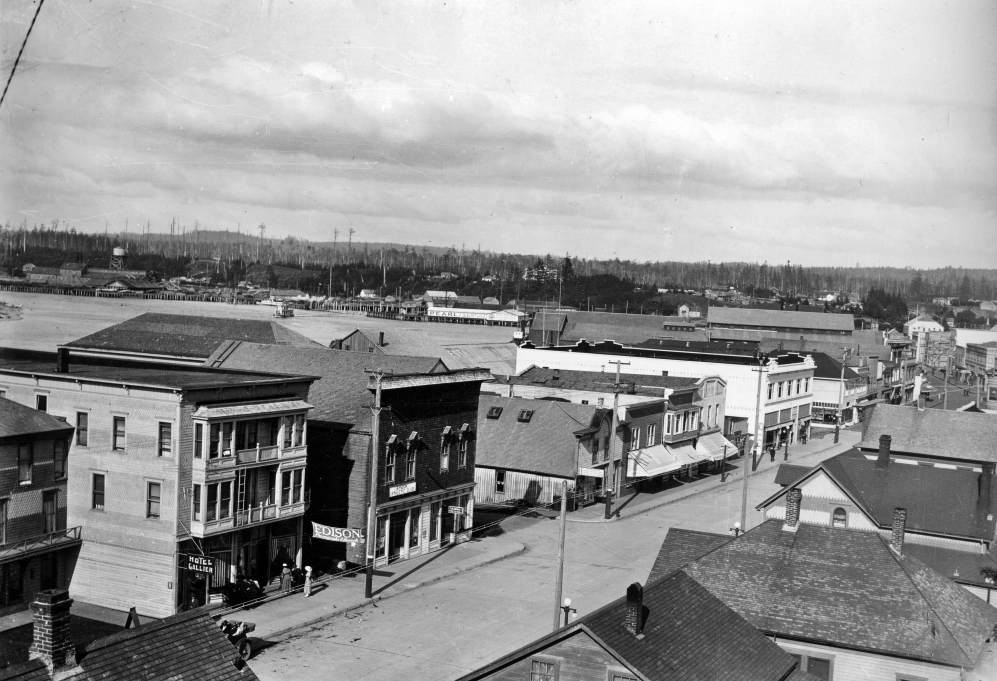 West end of First Street before the fire
West end of First Street before the fire
I'm not sure when this picture was taken, but I have chosen it because it is a good picture of the Gallier Hotel, which is the three-story building at bottom left. If you look carefully you can see the Hotel Gallier sign on the west side of the building.
I found a cool story in the May 11, 1916, Western World about the hotel. "Bandon narrowly escaped the ravages of another big fire when through the prompt action of E.M. Gallier with the aid of a patent fire extinguisher, a threatening blaze was put out in Room 2 on the second floor of the Hotel Gallier."
(The other 'big fire" that the writer, who was probably my grandfather, was talking about was the fire of June 19, 1914, which destroyed a large part of the business district east of this area. Little did they know what lay ahead for the town 20 years later).
"One of the lady vaudeville performers appearing at the Orpheum this evening had left a coal oil stove burning in her room while she went down town. The flame of the stove apparently crawled up until it reached through the top, and the casing of the sheet iron affair became a red hot furnace. A celluloid comb on the dresser caught fire and ignited the dresser itself. The floor took fire and an umbrella hanging across the room from the stove burned up. The plastered walls saved the day however.
"The blaze was discovered by Mr. Lemanski, who, while passing down the hallway, noticed the smoke emanating from the transom. He spread the alarm and Mr. Gallier promptly appeared on the scene. He had a hard battle and in the act received an ugly burn on the left side of his jaw and neck. His wound is not serious but has caused him considerable pain.
"With an unusually strong north wind blowing, the fire, if exposed to a draft, would soon have gained such headway that it would have been impossible to overcome it. The hotel building is situated so that a large part of the town would have burned down."
The hotel was located near where the old Coast Guard building sits today.
The second picture is of the Quonset Grade School, which opened in east Bandon in September of 1949. This picture was probably taken sometime in the '50s, but it looked pretty much the same for many years.
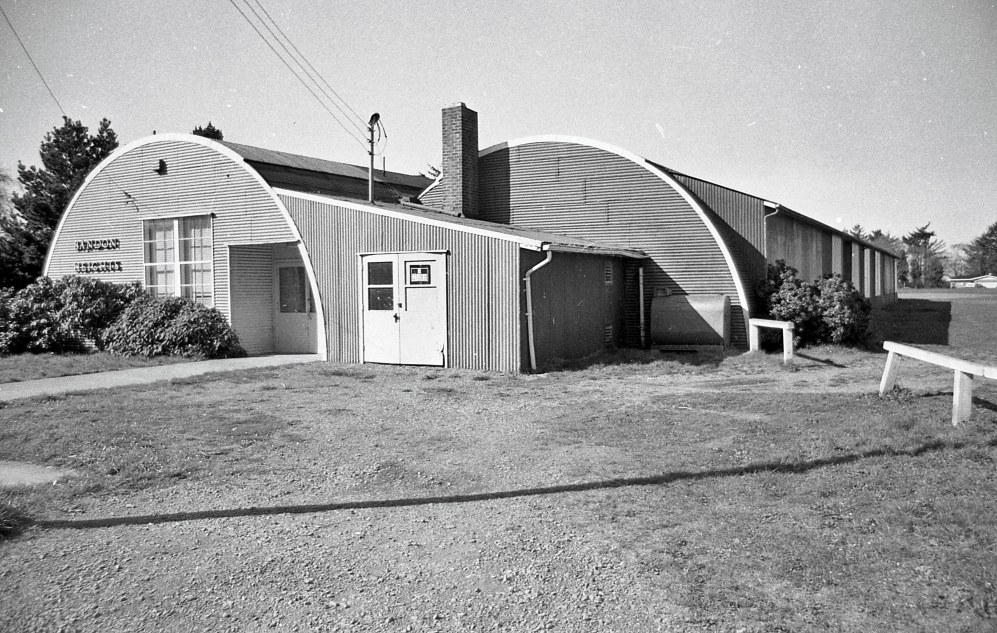 Quonset Grade School, 1950s
Quonset Grade School, 1950s
An article in WW says that "First, second and third graders inaugurated the newly completed North Bandon grade school Monday, when classes were begun in the quonset type structure for the first time."
Teachers were Mrs. Lucy Jacobs, third grade and head teacher; Mrs. Winnifred Ray, second grade, and Mrs. Nellie Biggar, first grade.
"The building extends east and west, with entrances at both ends of a full-length hallway. Entering through the main entrance on the east (pictured above) one sees the furnace room on the right, housing an automatic oil-burning hot air heating system, outside the main structure. All rooms are on the south side of the building."
This building was later removed and replaced with the quonset hut-type building that sits there today, and I believe houses baseball equipment for the high school and may provide a practice center during bad weather.
The third picture was taken in May of 1971 as Western Bank employee Joye Van Leuven (now Olson) accepts a check from members of the Measure-Up 4-H Club for the Community Scholarship Fund.
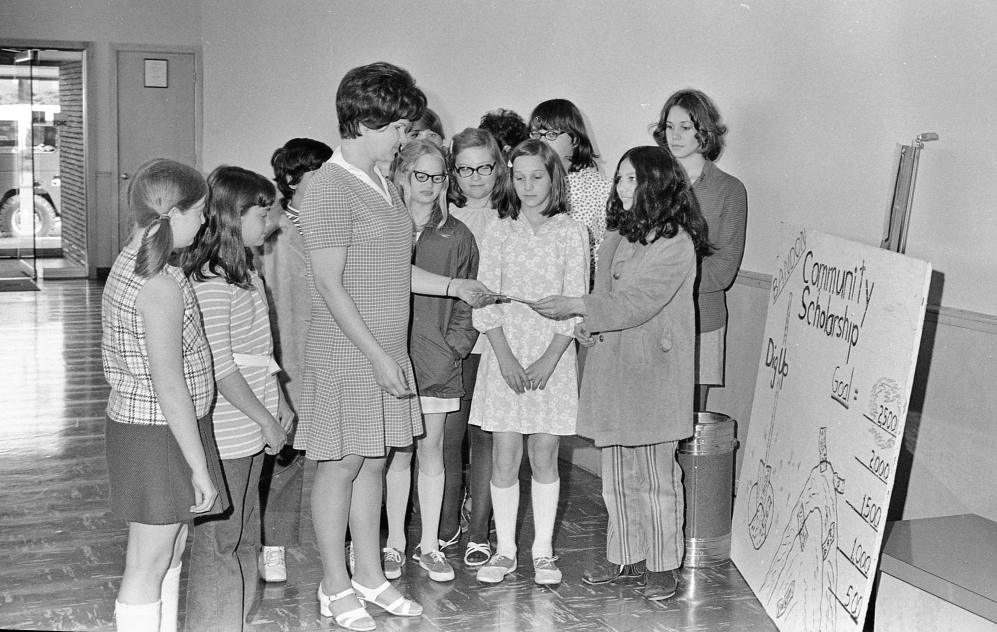 Measure-Up 4-H Club, 1971
Measure-Up 4-H Club, 1971
I can see Allison Jones next to Joye, Teena Manes next to her, in back Mary Franson and beside her is one of the Gardner sisters. It may be Dixie Wilson handing Joye the check.
* * *
I found another article that could easily have been written today .... but in the Feb. 26, 1920, Western World, headlined "City Goes Under 'Flu' Ban at Noon Today."
It seems that at a combined meeting of the city council and the school board, the decision was made that because of the increase in the number of influenza and small pox cases, schools were closed at noon that day.
At that same time an order went into effect prohibiting house parties, basket ball games, dances, lodging meetings, shows, churches and all other gatherings of similar nature. The order was effective for a week and was to continue longer if necessary. Several deaths had occurred in the county that week.
* * *
While we are on the subject of pandemics, I thought it was interesting to read a Facebook post Sunday from something called "Coos County News Network," indicating that I had joined a coalition of cities urging businesses to reopen on January 1.
The coalition was started by Mayor Stan Pulliam of Sandy, and even though I sympathize with the sentiment that led them to take this stand, I chose to help the Coos Bay City Manager write a letter to the Governor, which was signed by a number of elected officials in the county, including Coos Bay Mayor Joe Benetti, County Commissioner Melissa Cribbins, North Bend Mayor Jessica Engelke and I.
My fear is that if the restaurants and bars in those cities who supported Mayor Pulliam's position go ahead and open, they stand to have OLCC suspend their liquor license or to be fined by OSHA. That is the big problem with defying rather than trying to work with the Governor.
The letter that I signed onto said, in part: "We and many of the constituents we represent are concerned regarding the current pandemic restrictions on businesses in Oregon as they have resulted in devastating impacts to our lodging, restaurants, fitness, and entertainment sectors. These restrictions are adversely impacting lower-income workers the hardest."
It goes on to point out that available data and research indicates that business-related restrictions have little impact on the spread of Covid-19... quoting research in New York that showed that restaurants and bars accounted for only 1.4 percent of the virus spread.
It adds: "While restaurants, bars, fitness centers and indoor entertainment has been shuttered for months in and around Portland, the virus is still spreading. That spread has been attributed to small social gatherings where arguably virus protection best practices are not being followed."
The letter ends ....."we are urging you to reduce the metrics and restrictions on Oregon businesses. The longer the current restrictions/metrics are in place, the greater the adverse impacts will have both short term and long term on our small businesses, the Oregonians they employ, and our overall economy which is not in the public's interest!"
* * *
I heard this week from my childhood friend Margaret Huntington Ward, who lives in Lake Oswego and has been married to former Chicago White Sox baseball standout Pete Ward for many years. Her father, Ben C. Huntington, was superintendent of schools here back in the late '40s before they moved to Vida where he was head of the McKenzie River School District.
Margaret told me that her husband suffers from the advanced stages of dementia, and that their son, Steve, was hospitalized with the corona virus in mid-December, and died last week of cardiac arrest as the doctors had run out of options.
It was good to hear from her, even with such sad news.
* * *
I was pleasantly surprised to see the Quote of the Day in last Monday's New York Times was by an old friend of mine, Adam Zimmerman, who heads the nonprofit organization, Craft3, which gives loans to small businesses in Oregon and Washington and received $10 million as part of Mackenzie Scott's $4.2 billion giveaway.
Mackenzie is the former wife of Amazon founder Jeff Bezos.
Adam was quoted as saying: "Usually you don't have very large philanthropists wandering the landscape looking to drop millions of dollars very quietly into organizations that they care about. The first email literally got stuck in my junk mail," said Zimmerman, who started out as a RARE student with the City of Myrtle Point over 20 years ago, which is how I got to know him.
Craft3 was also one of the original funders of the Face Rock Creamery.
The non-profit is well known for assisting companies throughout the Northwest, and it was fun to see that Adam was still there after all these years.
As I See It
by Mary Schamehorn

Dec 23, 2020
The first picture I am sharing is one of the old Bandon City Hall taken during the flooding of Ferry Creek in 1961. But the story has nothing to do with the flood, but more with the old building.
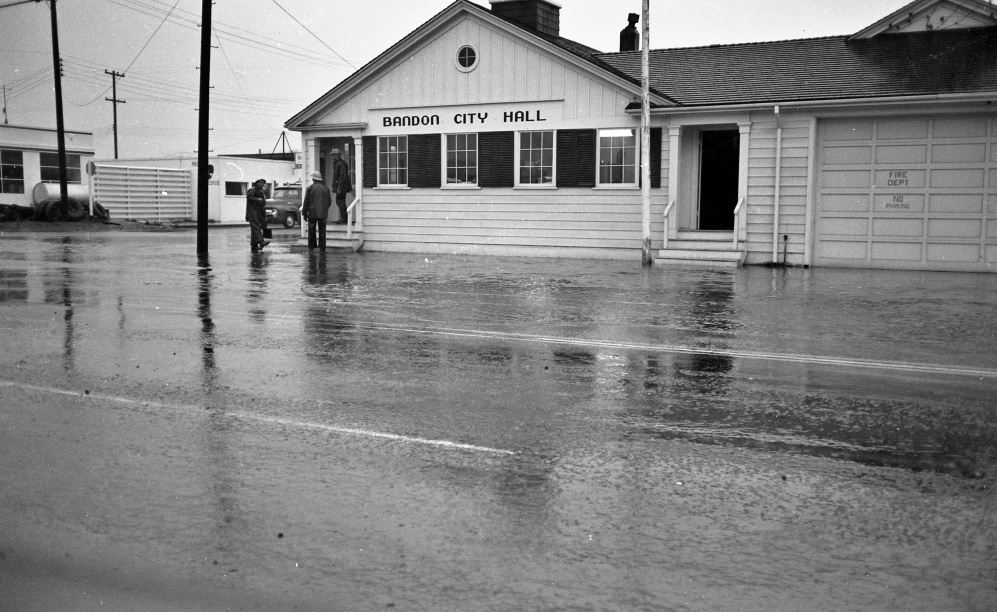 Bandon City Hall, 1961
Bandon City Hall, 1961
In an article in Western World, dated Jan. 20, 1937, which would be just a few months after the fire, the headline reads: "Future City Officials to Remember the Fire."
"Years in the future, when the children of present citizens of Bandon gather around the council table as mayor and councilmen to carry on the administration of the city's affairs, under the regime of a New Bandon, they will have a constant reminder of the sacrifices made and the efforts put forth in the reestablishment of the city," read the article in Western World.
What the city fathers had in mind was to resurrect the chassis from the remains of the Standard Oil truck, which I talked about recently in relation to pumping gas at the Capps Garage on the night of the fire. The Capps Garage and the gas truck were destroyed in the fire.
The paper explains that "The idea was to retrieve the chassis, remove all but the frame and wheels, convey it to the city hall and build upon it a table top to become the official council table of the City of Bandon."
(Unfortunately, even though the article alludes to something that would become a permanent memento in city hall, I do not think they ever carried through with that promise. To my knowledge there is nothing at the "new" city hall, which was built in 1970, to remind us of the fire.) Previous to constructing the present building, the city hall (pictured above) was at Highway 101 and Fillmore where the museum is now located. It was built by the WPA shortly after the fire and served 34 years as the city hall, fire hall and the library.
An article in the Jan. 20, 1934, Western World is headlined: "Moving into WPA City Hall.
"Bandon's new WPA City Hall will be occupied today. The offices of the City of Bandon are being moved from the temporary building, formerly Red Cross building, to the larger and more serviceable structure just completed.
"The building constitutes one of the most valuable contributions yet made toward the rehabilitation of Bandon. It is likewise a monument to the practicability and the efficiency of the Works Progress Administration."
Is important to point that that this building was finished and ready for occupancy less than four months after the fire. Today, you would barely be through the permit process.
The second picture I am sharing is on loan from the museum, and illustrates a story I found in the May 31, 1934, Western World about a man whose life was saved by mud. I do know that the man driving the horse and buggy is Henry Flanders, a pioneer of Bandon.
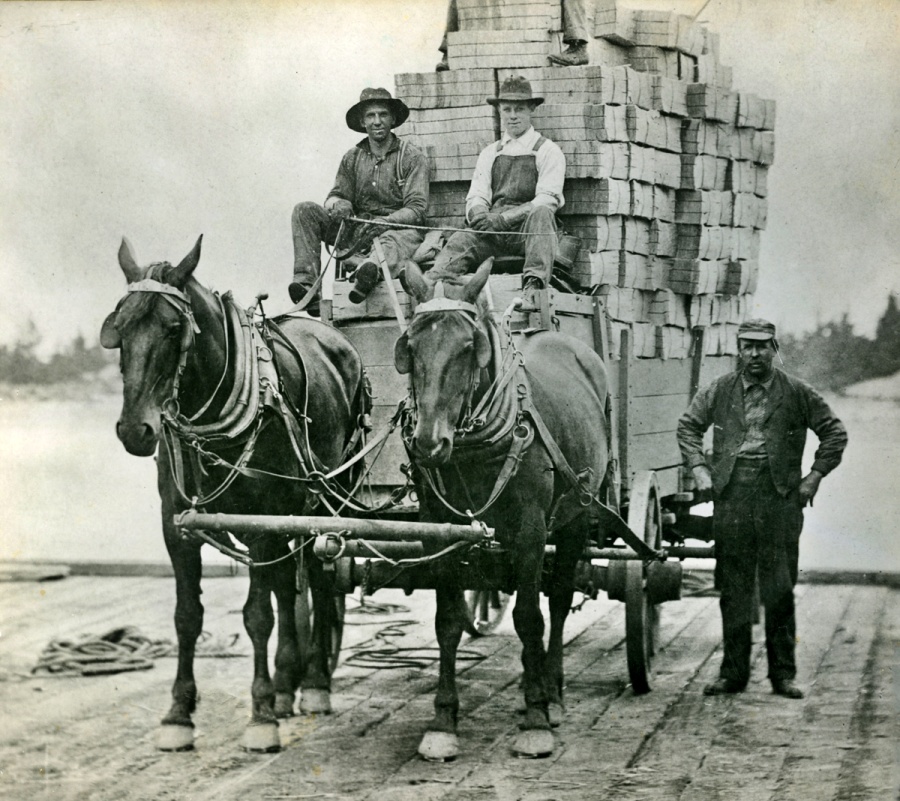 Driver: Henry Flanders, 1934
Driver: Henry Flanders, 1934
Here's what the article said: "Walter Wilcox of San Francisco, who has been living at the H.A. DeLong home on Fourmile, narrowly escaped death in an accident on the Alton McCue place on Fourmile Saturday. He was driving a team hitched to a heavy wagon loaded with fence rails (see why I picked this photo). In crossing over a piece of corduroy road across a swampy place, some of the rails slid forward and struck the horses and they started to run away.
"Wilcox slipped as he jumped and landed between two corduroy pieces in the road directly under the front wheel. The mud between the corduroys was soft, so when the front and rear wheels, carrying a load of several tons, passed over him, they squashed him down into the mire until he was almost out of sight. He was extricated and carried to the house. Dr. Arthur Gale was called and found several cracked ribs and a terribly brushed body but no serious internal injuries."
Google had this to say about a corduroy road: "A type of road made by placing logs, perpendicular to the direction of the road over a low or swampy area. It is a hazard to horses due to shifting loose logs."
I love this third picture, although I confess I could find neither the negative or the glossy photo, so I was forced to copy this out of the Nov. 17, 1949, Western World. Not sure how good it will print.
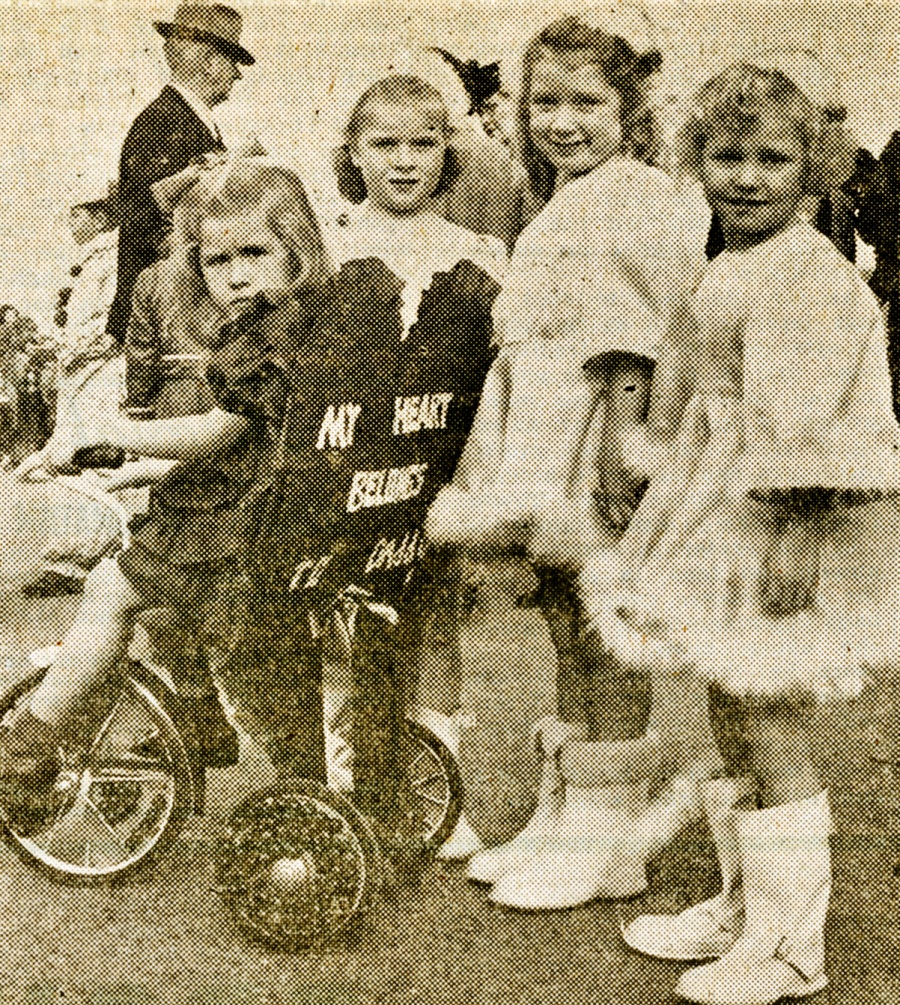 Cranberry Festival parade, 1949
Cranberry Festival parade, 1949
The three little girls, dressed in white Russian Cossack outfits, won a prize in the Cranberry Festival parade. The girl on the tricycle is Mary Jane Hartley. The three little dancers, who were in Evelyn Chesselet's dance class, are, from left, Carol Tucker (Acklin), Margaret Lorenz (Tiffany) and Sue Sweet. A fourth dancing girl, Lorraine Tucker, was not present when the picture was taken.
Margaret passed away not long ago, but Carol and Sue still live in the area.
It is also cool to note that the Cranberry Queen that year was Joan DeCosta (now Goodbrod), who now lives in an assisted living facility in Woodland, Wash. I talked to Joan on Sunday. She celebrated her 88th birthday last week, and was joined by daughter Michelle and the latter's boyfriend, Dale, who took her to Dairy Queen for a take-out meal, which they ate in the car.
Joan wants her Bandon friends to know how much she misses them, but wanted me to tell them that there have been no cases of the Coronavirus in the facility, so even though she hasn't been to Michelle's house since March she still keeps in touch with Michelle and her other daughter, Cindy (who lives in Utah), by phone.
She hopes that Michelle will bring her to Bandon next summer so that she can gather at Holy Trinity Catholic Church (her long-time church home) and greet her friends. "I have such a soft spot in my heart for Bandon," she said.
* * *
Just after I had written my column tonight, I decided to go out on the front porch and water my plant. Just as I was headed back into the house, I spotted a parcel lying on the sidewalk IN FRONT of my porch, which has a roof, although it's not enclosed. And this was on Sunday. I could tell by the weight of the rain-soaked package that it had probably been there since at least Friday. It had come from Talbots and had a USPS tracking sticker on the front, but it definitely was not delivered by the US Postal Service because I have a post office box and do not get my mail at home. That is unless it comes from a company who will only deliver to your home address, but this the first package I have ever received that was not left on the porch!
I hurried into the house and ripped open the soaking wet package and discovered a $340 reversible wool coat (the most expensive thing I have ever purchased even at half price); Thank heavens Talbots had put it in a plastic bag, so, while it felt damp and cold, I do not think it was ruined.
I would love to talk to the person who thought it was OK to throw it on the sidewalk in the dead of winter .... when a covered porch was a foot away, but I guess I should just be glad it was wrapped in plastic.
I have heard many complaints lately about the post office, and the time people have to stand in line waiting for a package or to mail a package, but believe me I know that if the package had come to the post office, it would not have been soaking wet and nearly ruined!
* * *
Sunday's Oregonian had two very important articles in it, including Steve Duin's column titled "Is Mob Rule the New Abnormal?"
Steve is one of the best .... and he's been writing for the Oregonian for many years. I met him several years ago when he came to Bandon to interview me for a story about my saving 30,000 negatives from Western World, which were headed to the local dump. He is a level-headed guy who is not afraid to write about the wrongs that he sees (or the rights).
Here is what he has to say about the latest incident of violence in Portland, referred to as the "Red House on Mississippi Street."
"What are we left with in this broken city, now that we know that sovereign citizens in the Red House, and their heavily armed defenders, are safe and secure and comfortably beyond the law?" And it goes on from there.
The second item is an editorial written by the staff of the Oregonian titled "Put schools on path to in-person instruction."
I will quote from this important editorial.
"It was exactly what Oregon families have been wanting to hear for months. 'It is time to begin the process of getting more of our students back in he classroom,' the governor said last Wednesday, announcing dramatically loosened guidelines for schools to reopen for in-person instruction.
"The only problem for Oregonians is that the governor making such a strong stand for students was not Oregon Gov. Kate Brown, but Washington Gov. Jay Inslee."
"In making the announcement he emphasized his concern for the educational, social and mental well-being of children who have borne the brunt of this shutdown, reflecting the urgency that has been painfully missing in Oregon's own strategy for schools.
"Caution in the face of a pandemic is an understandable response. But Oregon's restrictions on schools have been far more stringent than other states and reflect a strange set of priorities."
The editorial goes on to point out that Washington has twice as many cases as Oregon and nearly 2.5 times as many deaths as Oregon.
"Reopening schools needs to be a priority not just in words, but action."
Since I am pretty sure many of my readers do not read the Oregonian, or sadly probably no newspaper at all, I felt the Oregonian's perspective was important to share on both of these timely issues.
* * *
I saw something on "60 Minutes" a couple of weeks ago that really surprised me. Since I had recorded it, I played it back a couple of times to make sure I had heard correctly.
A health care professional was quoted as saying that half of the babies born today in the United States and Europe will live to be 102 or 103 years old. Actually she might have said 104, but I am going to err on the "conservative" side.
* * *
Saturday's Los Angeles Times reported that the College Football Playoff semifinal that was to be played Jan. 1 at the Rose Bowl in Pasadena is headed to AT&T Stadium, home of the Dallas Cowboys.
The decision hinged on being allowed to have 400 to 500 (family and friends) spectators in the 95,000-seat stadium that includes more than 50 suites.
California's answer was "no," and the Tournament of Roses is headed to (the yellow rose of) Texas.
In a 95,000-seat facility, people could have been spread so far apart that they would have to contact each other by phone, but the answer was still no.
As I See It
by Mary Schamehorn

Dec 16, 2020
I have chosen the first picture to share this week because it is the Port of Bandon office that was built not long after the Bandon Fire of 1936.
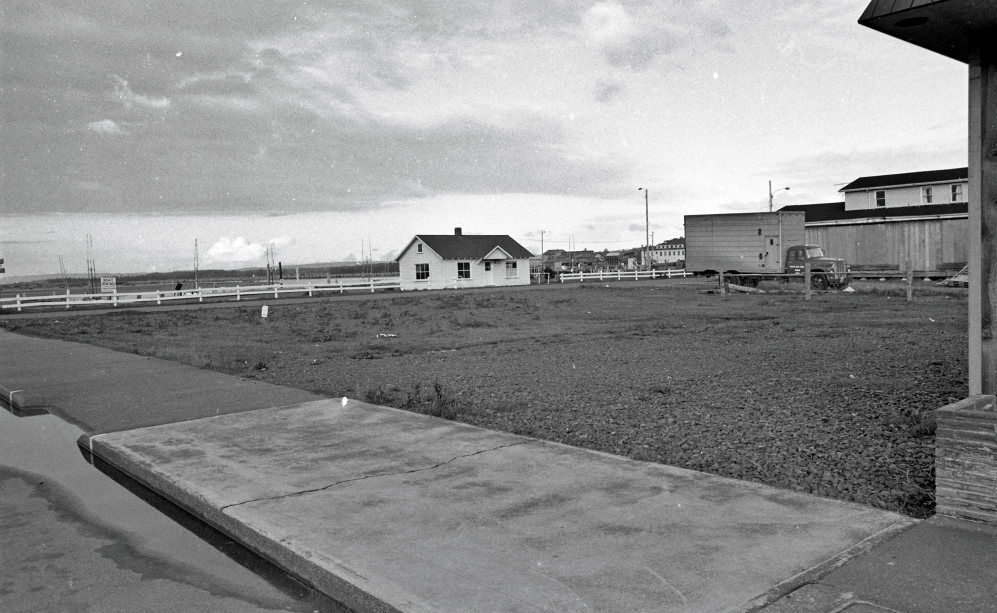 Port of Bandon office, 1960s
Port of Bandon office, 1960s
The Moore Mill Truck Shop and Moore Mill are visible in the background, and Panter Feed Store (now The Big Wheel) is at right.
The bare land in the foreground is now the home of the Arcade Tavern, which was built in 1973, so I am guessing that this photo was taken sometime in the '60s.
A headline in the Sept. 30, 1937, issue of Western World talks about the building. "Headquarters for the Port of Bandon and office for its assistant secretary, John Nielson, will soon be quartered in a new frame structure 18x30 feet that is being erected on the port waterfront property by members of the crew from the tug Klihyam.
"Since the fire of last September, the Port has had only the cramped temporary quarters of Mr. Nielson's office in which to carry on its business. After moving in the big Port safe, which was reconditioned, there was only standing room left and not for more than two people."
Several months later, another article said the port was now occupying the office.
"The building provides in addition to the office space a commodious room for holding port meetings. It has all modern conveniences."
Today, it is the home of Tony's Crab Shack, one of the thriving businesses on the waterfront.
I do remember seeing a picture of the port commissioners meeting around a table in that room years ago when Pete Goodbrod was on the commission .... and many of them were smoking in that tiny space. But that was the norm in those days.
The second photo was taken in January of 1958 when Jesse "Bud" Laub (see inset) opened his new Texaco Service Station at Highway 101 and Elmira.
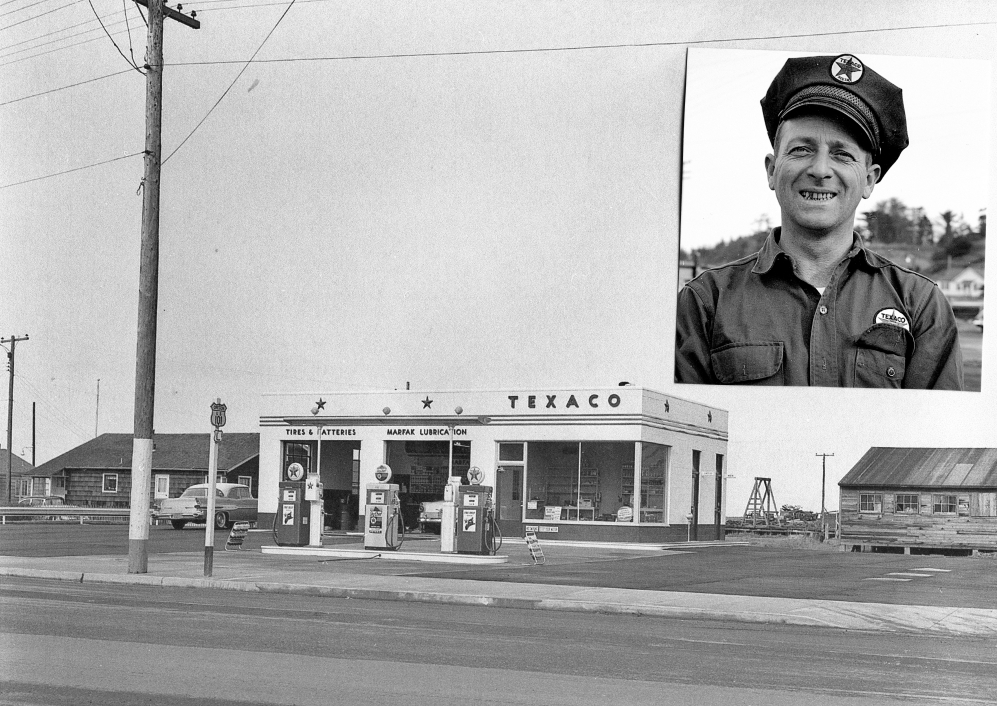 Jesse "Bud" Laub's Texaco Service Station, 1958
Jesse "Bud" Laub's Texaco Service Station, 1958
It was the site of the former Bob Otto Court, which survived the Fire, having been open only a couple of months when it burned in 1936. The property was purchased by the Texaco company in 1957, and the auto court/motel was torn down to make way for the new service station.
Today it is the home of the Chevron station that is on the same site. At far right you can see the old warehouse owned by Ernie Panter, at far left (nearly out of the photo) is the American Legion Hall, which at the time of the fire was one of the buildings erected by the Red Cross. It is across Delaware Avenue from the building pictured that is now the dental office of Dr. Sharen Strong.
Moore Mill's office is now located where the Panter building was in this picture.
A native Bandonian, Laub drove truck before he leased the station from Texaco.
An article in Western World explains that Mr. and Mrs. (Jean) Laub were former operators of the grocery store at Wintersville, at the top of Bear Creek Hill.
Taken in April of 1958, the third picture I am sharing is teacher Lloyd Gabriel's Great Decisions class.
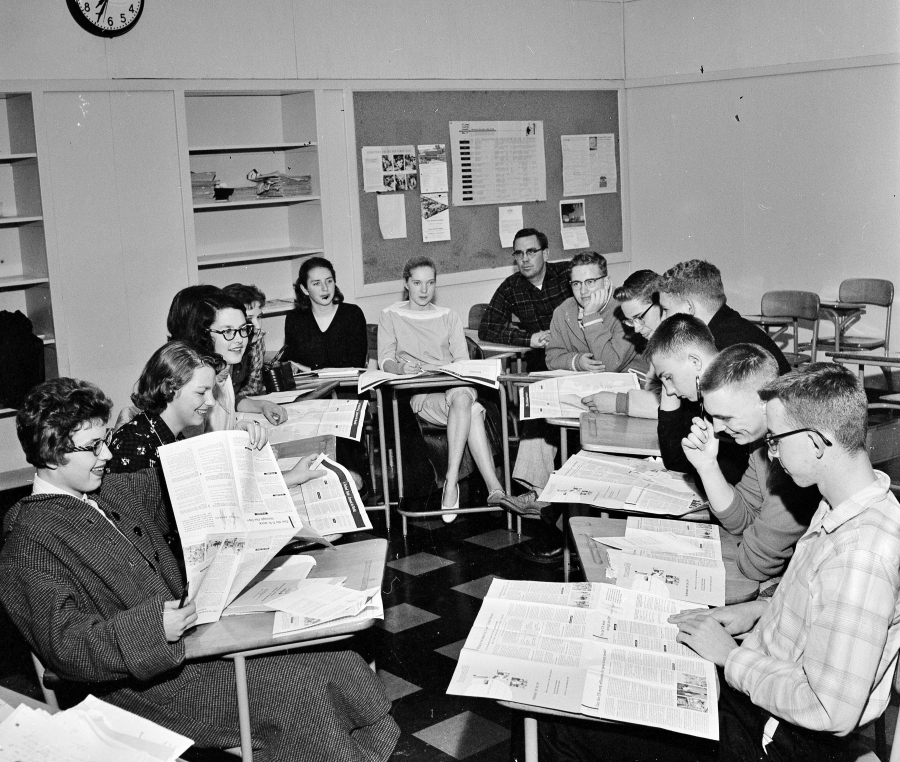 Lloyd Gabriel's Great Decisions class, 1958
Lloyd Gabriel's Great Decisions class, 1958
I have chosen to share this because I often hear from Mr. Gabriel (better known to his friends as Gabe) and in early December he just celebrated his 99th birthday. His wife, Ruth, who taught home economics at BHS in the late '50s, is 93. They now live in the Yakima Valley.
He was my American Problems teacher my senior year at BHS (1956-57) and he often shared stories of his time as a prisoner of war. Today he is state commander of the Ex-POW state department in Washington where they live.
Others in the Great Decisions photo, from left, are Linda Sutherland, Jane Chappell, Rhetta Bowen (behind her and not visible Judy Nuttbrock), barely visible Ronelda Riley, Joy Swenston, Kay Yockey, Mr. Gabriel, Weston Duggan, Larry Chalfan, David Lorenz, Louis Bohles, Gary Johnson and John Gamble. Both Swenston (now Tiffany) and Gamble have homes in Bandon.
* * *
I found an item in the December 1, 1949, issue of Western World that could just as easily have been written today. The headline reads: "Truancy No Problem; Parkersburg Pupils Rather Be In School."
It seems that "a group of children near Bandon like school so much they talked their teacher into foregoing a holiday last Friday, and having classes as usual instead.
"People at the Parkersburg school expressed regret on the day before Thanksgiving that not only Thursday but Friday, too, was to be a holiday. The teacher, Mrs. Harry Houghton, decided to put it to a majority vote of the pupils. They elected to have school Friday.
"There are 16 students in the school, and when class took up at the usual time Friday, 14 were present. They two who were missing had been absent several days, apparently due to illness."
My heart goes out to youngsters across the country, but most especially here in Bandon. So many of them want to be attending school. Distance learning simply isn't cutting it for many of them. They are missing so much more than just the Three Rs.
I know if you took a vote today, a majority of the kids would vote to be in school! And so would their parents.
After the Parkersburg school, like so many other small outlying school districts (Upper Fourmile, Lower Fourmile, Bear Creek, Bullard, Prosper, Randolph) closed, the teacher mentioned in the article, Mrs. Harriet (Harry) Houghton, taught in the Bandon grade school.
I also thought there was a school at Two Mile, but there was no mention of it in Bill Lansing's book "Remember When" which provides historic data about school districts in Coos County between 1850 and 1940.
* * *
I heard about a very disturbing incident that occurred last week near Bandon. It seems that around 4 in the afternoon last Tuesday, a woman was pulling onto the highway from Seven Devils Road. When she passed Weiss Estates, there was a gray SUV there. She made eye contact with a man who was fully masked, so she couldn't see his face. As she passed him, he pulled out behind her and turned on a very bright blue flashing light. She was confused and pulled over for a second. Then realized he wasn't a policeman, so she sped off. The man followed her into town and at the stop light by the shopping center, he made a U-turn. She said the vehicle appeared to be a Mitsubishi SUV. The license plate had either been removed or had a metal plate under it.
Later in the week, a similar vehicle was involved in an incident in Coos Bay. A man had been following a woman, who stopped at the ATM at Banner Bank, and after she walked over to the ATM, he jumped out of his SUV (also thought to be a Mitsubishi) and started stabbing her tire with a knife. He sped away before the police could get there.
If someone does try to stop you, particularly after dark, just turn on your flashers to signal that you know someone is trying to pull you over, but don't stop until you get to a well-lit place where others are around.
Police in the area know about this so they would understand if you don't pull right over.
* * *
We keep reading about the dangers that "flushable" wipes can do to a sewer system. But I read something recently that I never thought of, and thought I might pass it on in case you hadn't considered it either.
The writer said she had two friends who always flush the cat waste from the litter box down the toilet, and she wondered if it would cause plumbing problems.
The answer: "The pipes were clogged in our newly purchased house, causing everything to back up ... not fun. When we had the plumber come out, he showed us the video of the inside of our sewage pipes: almost totally clogged with 'flushable' cat litter by the previous owner.
"He said that he sees this problem ten times a month; you CAN flush the litter. It doesn't mean that your pipes won't get blocked, particularly in older homes. So don't flush anything with litter on it down the toilet. Apparently that stuff can set like cement. Ours could be rootered clear, but the plumber said he'd had to replace entire systems."
Knowing how much sewer system problems cost the city, it's certainly worthwhile advice.
* * *
For those of you who still haven't gotten your annual flu shot, you need to know that Coos Health & Wellness is offering a free drive-up flu shot clinic Friday, Dec. 18, at Pony Village Mall from 9 a.m. to 1 p.m. The clinic will be at the south end of the complex near the old Macy's store.
The health department is urging everyone to get a flu shot "to save healthcare resources for the care of patients with Covid-19. This means getting a flu vaccine this year is more important that ever," said a Coos Health and Wellness spokesman.
People wanting more information about Covid-19 can email the health department at covid19.questions@chw.coos.or.us.
As I See It
by Mary Schamehorn

Dec 09, 2020
I am doing things a little bit differently this week, as all three of my historic pictures will be part of the story of one of Bandon's oldest businesses, the Capps Motor Co.
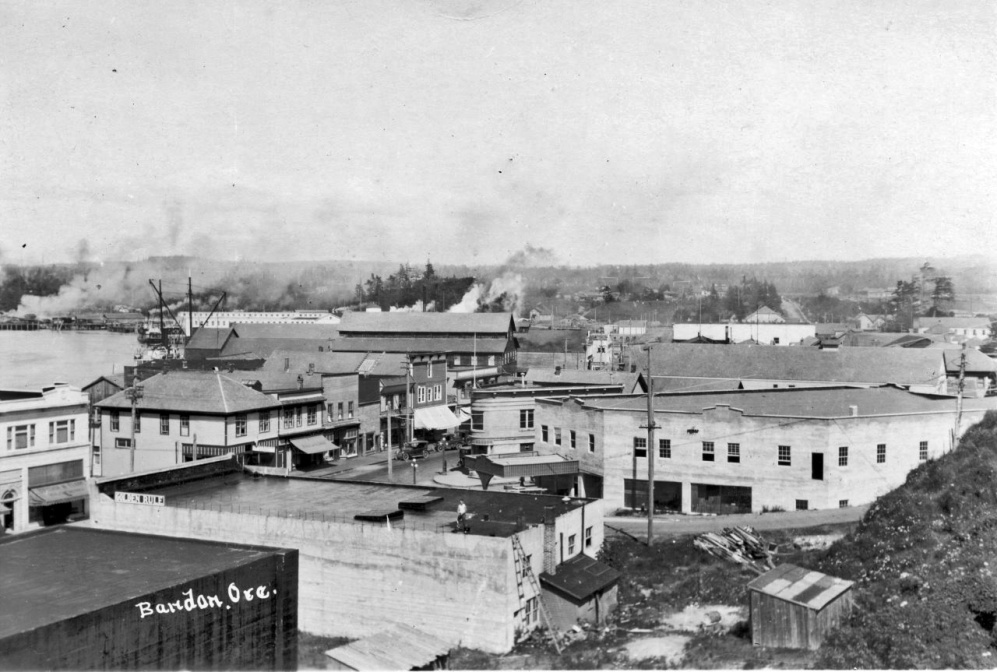 Capps Garage before the Fire of 1936
Capps Garage before the Fire of 1936
The first picture shows Capps Garage before the Fire of 1936. It is the building on the east side of Oregon Avenue, which was the main highway into town in those days. Today it leads down the hill past Holy Trinity Catholic Church and joins First Street across from the Port of Bandon's marketplace building. If you look closely you can see the overhang which covered the gasoline tanks in front of the big concrete two-story structure. West of Capps Garage is The Golden Rule, which after the fire relocated on Second Street in the building that is now the Continuum Center.
In an article in Western World, dated Jan. 21, 1937, which would be just a few months after the fire, an article tells how important the Capps Garage was that night.
"On the night of the big fire hundreds of cars drove up to the service station of Mayor Ed Capps to fill up with gas, preparatory to their contemplated flight to safety. All evening long, car after car stopped and without hesitation, the faithful attendants at the station pumped out the gas. The drain on the storage tank was greater than that of the ordinary Saturday night so a call to the Standard Oil Co. plant brought Manager Hal M. Howe with a truckload of gas to replenish the fastly diminishing supply.
"As fast as the gas was being emptied into the storage tank the pumps were drawing it out. And so on into the night. Flames from the raging forest fire drew nearer and nearer, pump attendants worked faster and faster. All the time the tank truck stood by, furnishing the supply that made it possible for many families to flee from the oncoming inferno and thereby probably saving the lives of many who might have been caught in the path of the oncoming tide.
"Finally, when the great tongues of hell were reaching over the hill and dipped into the roof of the Capps building, the heat became so intense that all were forced to abandon their stations.
"The following morning, after the crumbled mass of concrete and iron that had been the Capps Motor Co. plant had cooled off sufficiently to warrant inspection, there was the charred and twisted remains of the Standard Oil tank truck that had so heroically stood by the night before.
Ed Capps, owner of the company, first established the business in Bandon in 1922, and soon after took over the Ford agency.
The large concrete building, which was described in a 1951 article as being located at Bandon Avenue and Wall Street (the street which ran under the hill below the Catholic church but has long since been vacated), was considered a safe haven for cars and household goods by many citizens during the fire, but the intense heat destroyed it, along with most other concrete structures of that time.
Willis Baker, for example, who was in charge of the Oregon State fish hatchery east of town, brought his family possessions to the Capps building; it burned. His home survived.
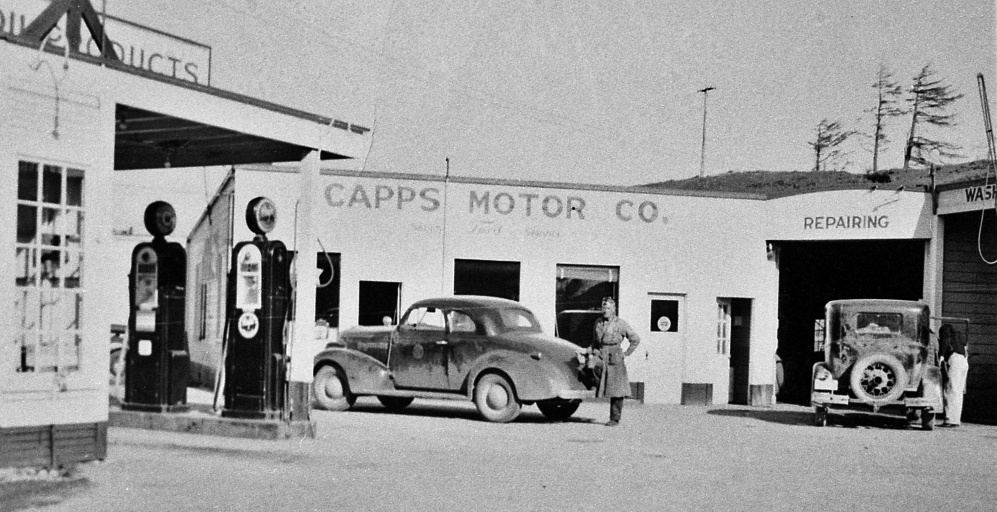 Capps Garage after the Fire of 1936
Capps Garage after the Fire of 1936
Immediately after the fire, Capps built the service station and garage (which you see in the second picture) across Second Street from his new building, which had its grand opening in August of 1951. The old service station was torn down in March of 1969.
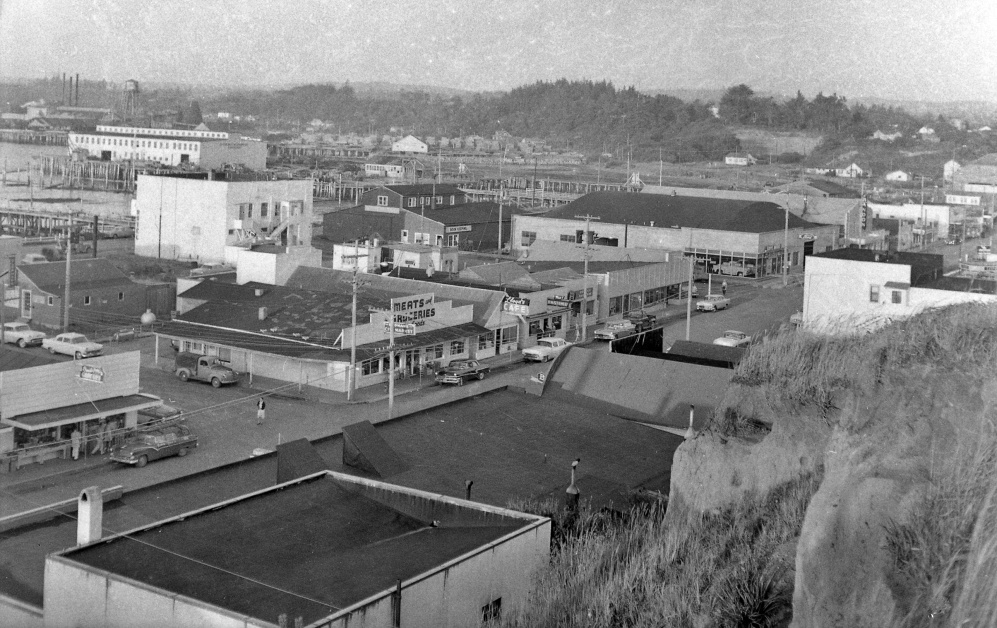 Capps Motor Co., 1959
Capps Motor Co., 1959
You have to look a bit to find the Capps Motor Co. building that Capps erected in 1951. This picture was taken in 1959, and you can see Erdman's City Market (Meats and Groceries), Lloyd's Cafe (small space in those days before owners bought the Erdman's building and expanded into the space it occupies today), Pastime Tavern (now Sweets & Treats), Boone's Hardware and the complex, which Merritt J. Senter and other businesses occupied over the years, and is now owned by Lynn Davies and her daughter, Jessica Brink. Across Chicago you can see the large Capps Motor Co. building, which is now owned by Kirk and Elizabeth Day and occupied by Washed Ashore, Broken Anchor and a real estate office. If you look closely, you can see new vehicles in the Capps showroom. Just to the east is the Bandon Theater, which was later torn down.
The article in the Aug. 2, 1951, issue of Western World describes the new Capps building in glowing terms.
"The new building is among the most modern automotive plants in Coos County, including spacious showroom, service department, special body repair and painting rooms, huge parts department, office and new equipment.
"Capps has been one of the leading businessmen of Bandon for nearly 30 years. He was mayor of Bandon at the time of the fire and afterwards, and his large investment in the modern new automotive plant is seen as indicative of his continuing faith in Bandon's future."
The article was written by my grandfather, L. D. Felsheim, who worked closely with Mayor Capps in helping Bandon to rebuild as owner of the Western World.
* * *
Talk about frightening. An incident that occurred Saturday on the North Oregon coast near Tillamook could have been a lot worse. A rockslide trapped as many as a dozen people at the Oceanside Tunnel Saturday morning, forcing an emergency plan to rescue them before an incoming tide arrived.
The rockslide occurred at 10:45 a.m. at the south opening, and it was necessary to rescue people trapped on the north side of the tunnel. They were rescued one by one through a three-foot opening at the Oceanside beach. The rescue operation took about 25 minutes, and all were required to wear hard hats as rocks were continuing to fall. A spokesman for the Netarts Fire and Rescue said some people climbed the cliff to get out.
Oregon State Parks closed the tunnel access until further notice.
* * *
An article in The Oregonian is extremely disturbing, and shows the extremes to which people are taking their concerns.
"About 50 right-wing protesters converged on the Silverton home of a state workplace safety regulator on Sunday to protest a large fine levied against a Salem gym owner."
The police chief said there were no problems or issues. He said they stayed on the sidewalks and off private property.
I saw a Facebook post this week on the Bandon, Oregon Facebook page urging people to join in a similar protest in front of the home of the OSHA director Michael Wood.
I suggested that there might be other ways to express your concern rather than intimidating a state official, who was carrying out the mandates of Oregon Governor Kate Brown.
I was on a call last week where Wood and other state officials were talking about Covid 19 and the escalating number of cases. I found him to be a caring concerned person, and I can't come to grips with the idea that he, his family and his neighbors need to be subjected to this kind of intimidation.
A group from the other "camp" recently converged on the home of Portland's new city commissioner, broke out a window and set fire to property because he would not vote to further defund the Portland Police Department.
I understand the frustration and desperation of small businesses across the state, who are having a hard time coming to grips with the inconsistencies of the rules that are coming out of the governor's office.
I don't care which side you're on. This kind of tactic is never the answer.
* * *
Meanwhile if you want a stark illustration of how the Coronavirus is spiraling out of control in the United States, look at these 2020 monthly case numbers compiled by NBC News:
March, 188,200; April, 883,199; May, 723,166; June, 845,736; July, 1,926,970; August, 1,479,756; September, 1,215,901; October, 1,940,522; and November (as of 9 a.m. Nov. 30), 4,252,822.
* * *
Sharon Ward Moy just posted on Facebook that Geraldine Cox (now Gerrie Fuller), a member of the class of 1964, is hospitalized in Kentucky with Covid. She reports that is it terrible and that she is struggling to breathe.
We certainly wish her a full recovery.
As I See It
by Mary Schamehorn

Dec 02, 2020
The first picture I am sharing this week is the new Bandon Theatre, built shortly after the Bandon Fire of 1936 by Dick Fisk, who owned other theaters up and down the coast, including one in Gold Beach.
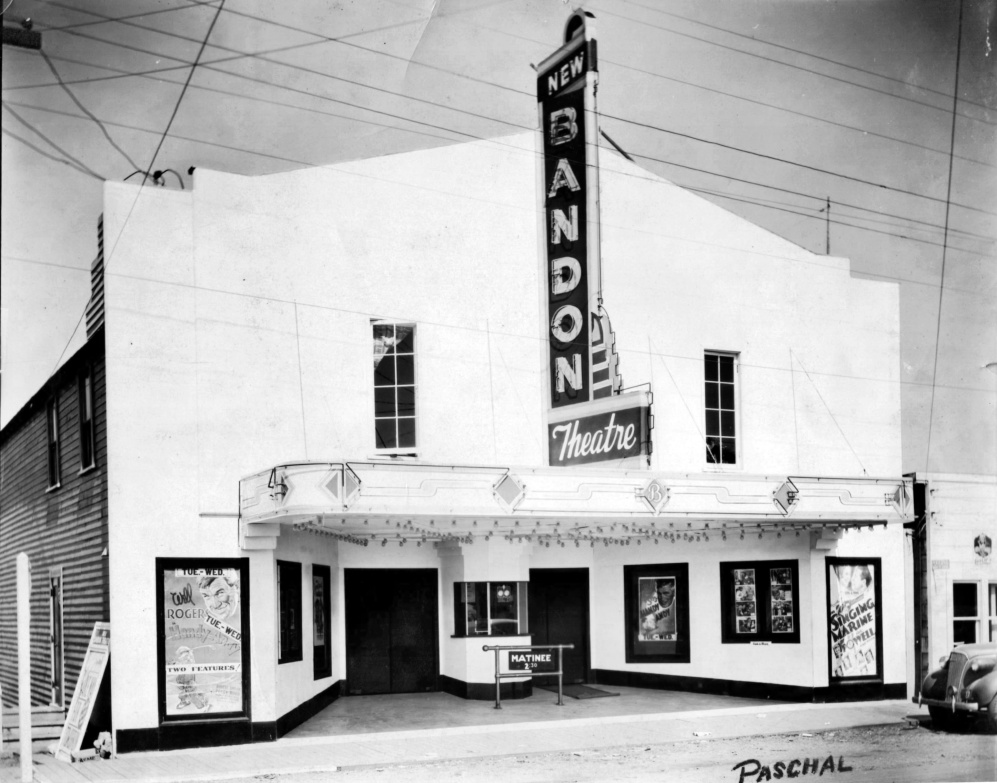 Bandon Theatre, 1930s
Bandon Theatre, 1930s
Two movies playing the day this picture was taken, probably sometime in the late 1930s, were The Singing Marine, starring Dick Powell, which came out in 1937, and Handy Andy, starring Will Rogers, which was filmed in 1934.
Before the Fire, Bandon had at least two theaters, the Hartman and the Rex, which were the bedrock of people's entertainment.
The Western World article of June 10, 1937, had this to say about the new theater: "The new theater building is far more complete, and more attractive than most people expected. The entire building was erected and the installations were made ready for the first showing in 32 working days.
"The building is more than a temporary structure. While of frame construction, it is so built that it can easily be encased in concrete walls, thus making it practically fireproof from the outside. An up-to-date steam plant will furnish heat for the structure, which is 42x117 feet. The stage is 14 feet deep, with an opening 42 feet wide.
"The seating capacity of the theater is 570 seats being fully upholstered. The new structure is modern in every respect with ladies' lounge and cosmetic room furnished in chrome steel.
"Living apartments are being provided on the second floor for Mr. and Mrs. Fisk.
"The shows are to be given each night, at 7 and 9 o'clock. Five different feature pictures will be shown weekly, with four changes."
I lived in the two-bedroom apartment upstairs from 1969 until 1976, renting from the then owners, Jack and Shirley Ward, for $75 a month.
The theater, which was torn down in 1985, was located where the vacant lot now sits between Bandon Coffee Cafe and the Harbor Town Events Center/Broken Anchor building.
As we head into winter I am reminded of the winter of 1979 when we were hit with a big rain and wind storm in February, which caused streets like this, in the second photo, to flood.
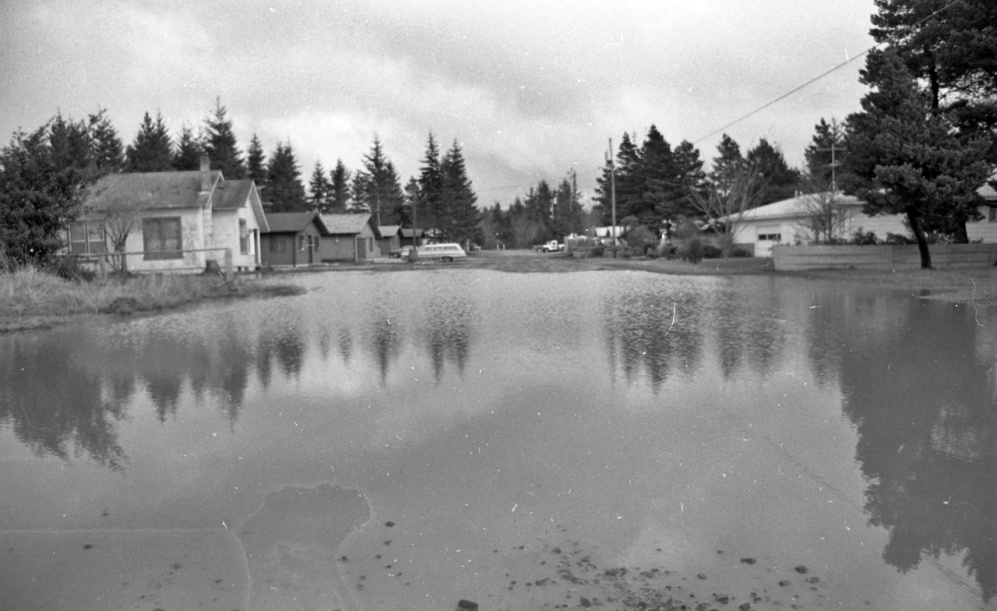 After the storm, 1979
After the storm, 1979
Rain, which dumped nearly 5 inches of water on Bandon during that week, completely covered Division Street off North Avenue, just north of Rumpty's (Now Rancho Viejo Mexican restaurant). Other roads, including Beach Loop, had water standing on them because of drainage problems.
Wind gusts up to 70 mph damaged signs, including the read-a-board at Buck's Sentry south of town, and played havoc with the new traffic stop lights at 11th and Highway 101. It also caused temporary power outages throughout town.
The third picture was taken at the GAR Cemetery on Memorial Day 1966.
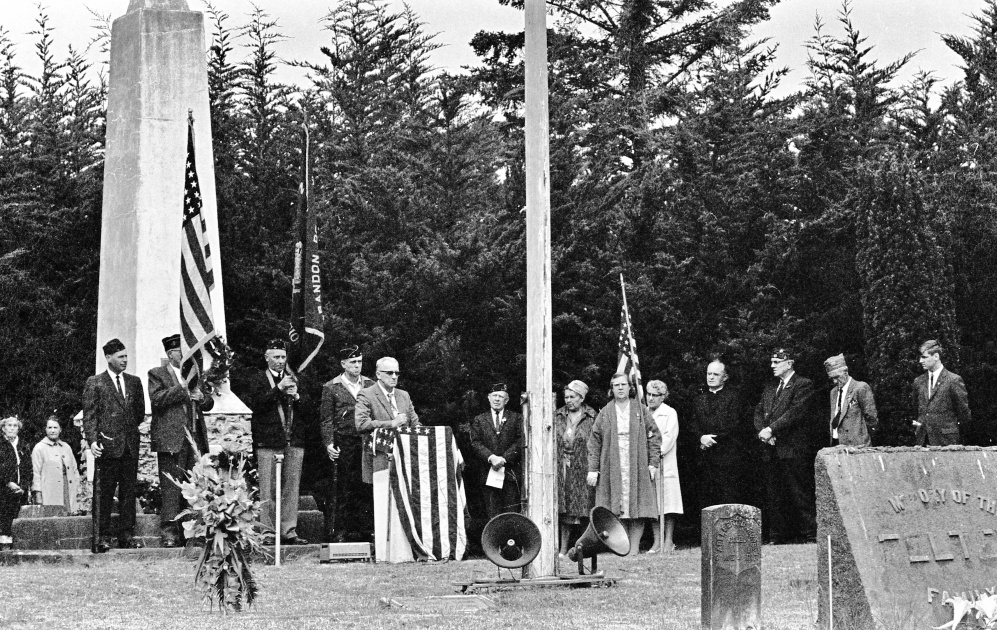 GAR Cemetery, Memorial Day 1966
GAR Cemetery, Memorial Day 1966
The featured address was given by Robert MacWhorter, at the flag-draped podium. Others either identified in the newspaper article or who I can recognize are H.M. "Max" Howe, to the right of MacWhorter, representing Bandon Post 26, American Legion; Clara Harris, Ruth Lennon (with flag), Father Alan Kennedy, William Stewart of Medal of Honor Post 3440, Veterans of Foreign Wars; Milford Harris, and BHS student Mike Mauzey, far right, who recited the Gettysburg Address. At far left, I think I see Vivian Kranick; and the man on the stage, at far left, I am sure is Jack Ward.
* * *
I was sorry to learn that Esther Williams, former chair of the Southern Coos Hospital District board of directors and the long-time chair of the city's Parks and Recreation Commission, died Saturday of colon cancer at the age of 84.
Esther had owned a Myrtlewood shop south of town, and for some years operated Brewed Awakenings on Elmira and 101.
She was a retired health care professional, who had worked for the health district before retiring.
* * *
I also learned that Joyce Yost Moore, a member of the BHS Class of 1952, died Nov. 23 at Bay Area Hospital. Joyce had worked in the school district cafeteria for years and then returned to school to become a beautician, later opening her own shop in the Wheelhouse building.
I know that her husband, Frank Moore, and her daughter, Joy Moore Hall, had predeceased her, and I believe she is survived by at least one son, Frank, as well as her half-brother, Bob Elliott of Bandon.
* * *
People keep asking me if I know what happened to Erik, who used to be in front of the post office every day. I do know that several people saw emergency medical technicians assisting a person in front of his house on Elmira Avenue some months ago. One of the police officers said he had been hospitalized following that event, but apparently he is no longer able to return to his favorite spot in front of the post office.
* * *
I know that the cranberry growers have completed their harvest by now, but I found an interesting item in the Oct. 4, 1945, issue of Western World. In even older papers I learned that, the school district pretty much excused students who stayed home to help their families with the harvest.
Here's what it was like in 1945:
"The cranberry harvest has started in the Bandon area at most of the bogs, but with altogether too few pickers to assure its successful conclusion before inclement weather sets in, according to prominent growers.
"At the L. M. Kranick bogs all methods of harvesting are being employed including water raking, dry scooping and machine picking, but their choice berries are being saved for hand picking. The Hooker and Fish bogs are to be machine picked and water scooped, while hand-picking is in progress at the Boak, Baker, Wilson & Nielson and Biescke bogs.
"Reports on all bogs have not been received but it is generally understood that all are short of pickers and ample opportunity is afforded all who wish to take part in the harvest."
Even today, growers rely heavily on family members and friends to help with the harvest.
* * *
I received a press release this week from the Oregon State Police concerning the capsizing of a small inflatable boat at the mouth of Netarts Bay, on the north Oregon coast.
A husband and wife from Fairview were crabbing with an electric motor when their boat capsized in heavy seas. Lyda Hong, 41, who was rescued by the US Coast Guard helicopter crew, survived because she was wearing a life jacket; her partner, Srun Hong, 53, was not wearing a life jacket and his body had not been found at the time the press release was issued.
It is interesting that the TV announcer had the same press release that I received, but she chose not to mention the fact that one was wearing a life jacket and the other wasn't.
It's an important message ....
* * *
The Governor has announced new regulations, effective Dec. 3, but instead of being statewide mandates, they have been issued county by county, in four categories: lower risk, moderate risk, high risk and extreme risk.
Restrictions vary depending on the category, which will be re-evaluated every couple of weeks.
At the present time, 21 of Oregon's 36 counties are in the extreme risk category, including the three big metro counties, Marion, Lane, Douglas and several Eastern Oregon counties.
Coos County is considered a high risk county; Curry is a moderate risk.
What that means for Coos County is that indoor social and at-home gatherings are to have a maximum of six people (recommended from no more than two households); for outdoor, the maximum is eight people.
Eating and drinking establishments are allowed to have indoor dining, not to exceed 25 percent capacity, with an 11 p.m. closing hour. Outdoor dining is allowed with a maximum capacity of 75 people, six per table; limit two households.
Indoor recreation and fitness establishments, like gyms, pools, K-12 sports, collegiate sports are allowed with a 25 percent capacity or 50 total (whichever is smaller). The same restriction is for indoor entertainment, including theaters, museums, etc.
Retail stores and indoor and outdoor shopping centers are allowed to be open with a maximum 50 percent of capacity, but are to encourage outside pick-up.
Churches, funeral homes and mortuaries are allowed at a maximum 25 percent capacity or 150 total (whichever is smaller); 200 outdoors.
Outdoor recreation and fitness establishments and outdoor entertainment establishments can have a maximum of 75 people.
Personal services, like barber shops and beauty parlors, are allowed, and visitation is allowed at long-term care facilities.
For the 21 counties in the extreme category, inside dining is not allowed, nor is indoor recreation or entertainment.
Previous columns by Mary Schamehorn
bandon.tv




















